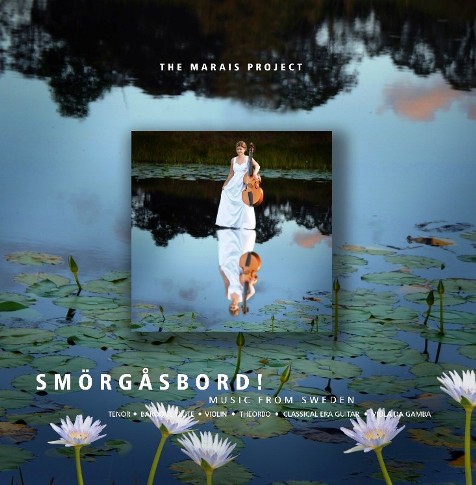Artists: Pascal Herington – Tenor, Melissa Farrow – Baroque Flute, Fiona Ziegler – Baroque Violin, Tommie Andersson – Theorbo and Classical Era Guitar, Jennifer Eriksson – Viola da Gamba.
Exuberant, gentle, fresh, mellow, scintillating, delightful… and so runs my list of superlatives after listening to this CD.
 The names of the artists involved speak for themselves; these are highly accomplished professional musicians who play and sing exceptionally well together. However as the name of the disc suggests, this is not all “Early Music” albeit a recording encompassing a variety of styles (especially Swedish Folk Music) through “the unique lens of period instruments”.
The names of the artists involved speak for themselves; these are highly accomplished professional musicians who play and sing exceptionally well together. However as the name of the disc suggests, this is not all “Early Music” albeit a recording encompassing a variety of styles (especially Swedish Folk Music) through “the unique lens of period instruments”.
I was quite delighted to be asked to review the latest (and 5th) CD from the project especially as it included some beautiful Baroque Flute music. Why music from Sweden? Well in the words of the directors of the project, Jennifer Eriksson and Tommie Andersson:
“We have been performing together in The Marais Project and many other ensembles for more than 25 years now. Alongside our shared musical loves, we also share a Swedish heritage. Tommie was born and grew up in Sweden, while Jenny’s Swedish grandfather, Knut Axel Eriksson, arrived in Melbourne in the 1920s.”
So Jennifer and Tommie began a three year project to explore music from their Scandinavian roots, which was at times quite emotional for them. The result is this disc of Swedish music including some quite diverse styles of music which pay homage to Early Music, Folk, Jazz and even Pop. I knew little of Swedish music prior to listening to the disc and was delighted to find that the Folk Music from Sweden in particular was so evocative and heart-felt. Beware if you are Swedish born…. I can promise you an attack of nostalgia and perhaps even homesickness!
For the Baroque fans there is a Flute Sonata by Johan Helmich Roman (considered the “Father of Swedish Baroque music”) and a Suite from Pieces en Trio by Marais which I believe was originally for 2 flutes with Basso continuo, but is presented here with Flute and Violin, with the Basso continuo provided by theorbo and viola da gamba. Both these tracks demonstrate a fine degree of technical expertise and musical ensemble by the players.
The Swedish folk music presented has all been arranged by Tommie Andersson. I very much enjoyed these arrangements, and if you, like me, don’t know Swedish, do read the translations thoughtfully provided by Tommie. I couldn’t help noticing the use of the flute in these arrangements. Acoustically, it generally works best to put the flute above the violin, however Andersson frequently drops the flute under the violin as a colour which merges and intertwines beautifully with the viola da gamba, and in that register it gives the music quite a lush sound. The quality of playing even evokes a slight Middle Eastern feeling. Swedish folk music is all about the violin. In the CD notes Tommie acknowledges the “talented and cross-culturally adaptable colleagues … Pascal (Herington) deserves special acknowledgement for getting his tongue around the challenges of Swedish pronunciation”. If you don’t know the name “Pascal Herrington” then add it to your list of tenors worth listening to.
For me, the jewel in the crown of this CD was the Pavane: Thoughts of a Septuagenarian by Esbjorn Svensson, arranged by Tommie Andersson. Svensson was a jazz pianist in the Swedish Jazz trio “e.s.t.” who tragically died at the age of 44 in a diving accident. The piece is very calm and reflective…even the dog in my lap grew heavy as we sat and listened and mellowed. There is a surprise at the end of the disc and I won’t spoil it for you. Think a famous Swedish pop group and an arrangement in the style of a Courante! I promise you…it works!
The booklet with the disc is a coffee table publication in itself with lovely art work all highly evocative of the music on the disc.
I don’t know what you listen to your CD’s on but if you have some good sound equipment do it the justice of listening, sitting right between the speakers. The disc, which was recorded at Studios 301 in Sydney, is well engineered and if you close your eyes you can almost imagine the group sitting in front of you in the room. A clean, well mastered recording, the stereo picture is true to life with just a slight enhancement of the diapason strings of the theorbo, which sometimes doesn’t quite come across in an acoustic performance. This creates a satisfyingly resonant bass line underpinning the musical texture. Hear the theorbo as the player hears it!
You can buy this disc on line if you go to the website www.maraisproject.com.au for just $25 plus postage. It will make a wonderful gift for that musically appreciative friend or relative who seems to have everything they could want.
Gillian Rankine
Early Music Queensland April-May 2015 Newsletter
